2013 CHRYSLER 300 coolant level
[x] Cancel search: coolant levelPage 519 of 592

(antifreeze) solution. The use of lower quality water
will reduce the amount of corrosion protection in the
engine cooling system.
Please note that it is the owner’s responsibility to main-
tain the proper level of protection against freezing ac-
cording to the temperatures occurring in the area where
the vehicle is operated.
NOTE: Mixing engine coolant (antifreeze) types is not
recommended and can result in cooling system damage.
Drain, flush, and refill as soon as possible to avoid
damage if coolant types are mixed in an emergency.
Cooling System Pressure Cap
The cap must be fully tightened to prevent loss of engine
coolant (antifreeze), and to ensure that engine coolant
(antifreeze) will return to the radiator from the coolant
recovery tank. The cap should be inspected and cleaned if there is any
accumulation of foreign material on the sealing surfaces.
WARNING!
•
The warning words “DO NOT OPEN HOT” on the
cooling system pressure cap are a safety precaution.
Never add engine coolant (antifreeze) when the
engine is overheated. Do not loosen or remove the
cap to cool an overheated engine. Heat causes
pressure to build up in the cooling system. To
prevent scalding or injury, do not remove the
pressure cap while the system is hot or under
pressure.
• Do not use a pressure cap other than the one
specified for your vehicle. Personal injury or en-
gine damage may result.
7
MAINTAINING YOUR VEHICLE 517
Page 520 of 592
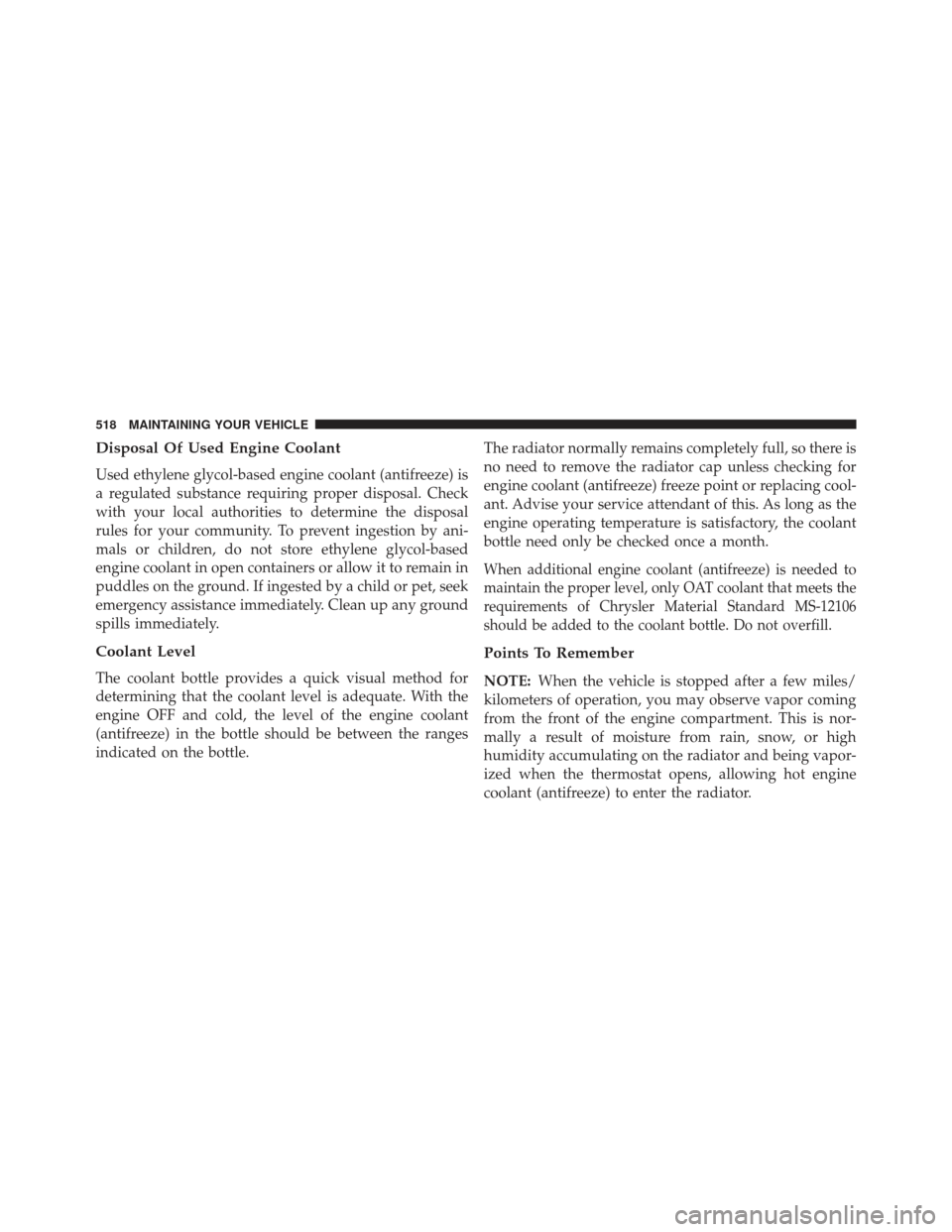
Disposal Of Used Engine Coolant
Used ethylene glycol-based engine coolant (antifreeze) is
a regulated substance requiring proper disposal. Check
with your local authorities to determine the disposal
rules for your community. To prevent ingestion by ani-
mals or children, do not store ethylene glycol-based
engine coolant in open containers or allow it to remain in
puddles on the ground. If ingested by a child or pet, seek
emergency assistance immediately. Clean up any ground
spills immediately.
Coolant Level
The coolant bottle provides a quick visual method for
determining that the coolant level is adequate. With the
engine OFF and cold, the level of the engine coolant
(antifreeze) in the bottle should be between the ranges
indicated on the bottle.The radiator normally remains completely full, so there is
no need to remove the radiator cap unless checking for
engine coolant (antifreeze) freeze point or replacing cool-
ant. Advise your service attendant of this. As long as the
engine operating temperature is satisfactory, the coolant
bottle need only be checked once a month.
When additional engine coolant (antifreeze) is needed to
maintain the proper level, only OAT coolant that meets the
requirements of Chrysler Material Standard MS-12106
should be added to the coolant bottle. Do not overfill.
Points To Remember
NOTE:
When the vehicle is stopped after a few miles/
kilometers of operation, you may observe vapor coming
from the front of the engine compartment. This is nor-
mally a result of moisture from rain, snow, or high
humidity accumulating on the radiator and being vapor-
ized when the thermostat opens, allowing hot engine
coolant (antifreeze) to enter the radiator.
518 MAINTAINING YOUR VEHICLE
Page 549 of 592
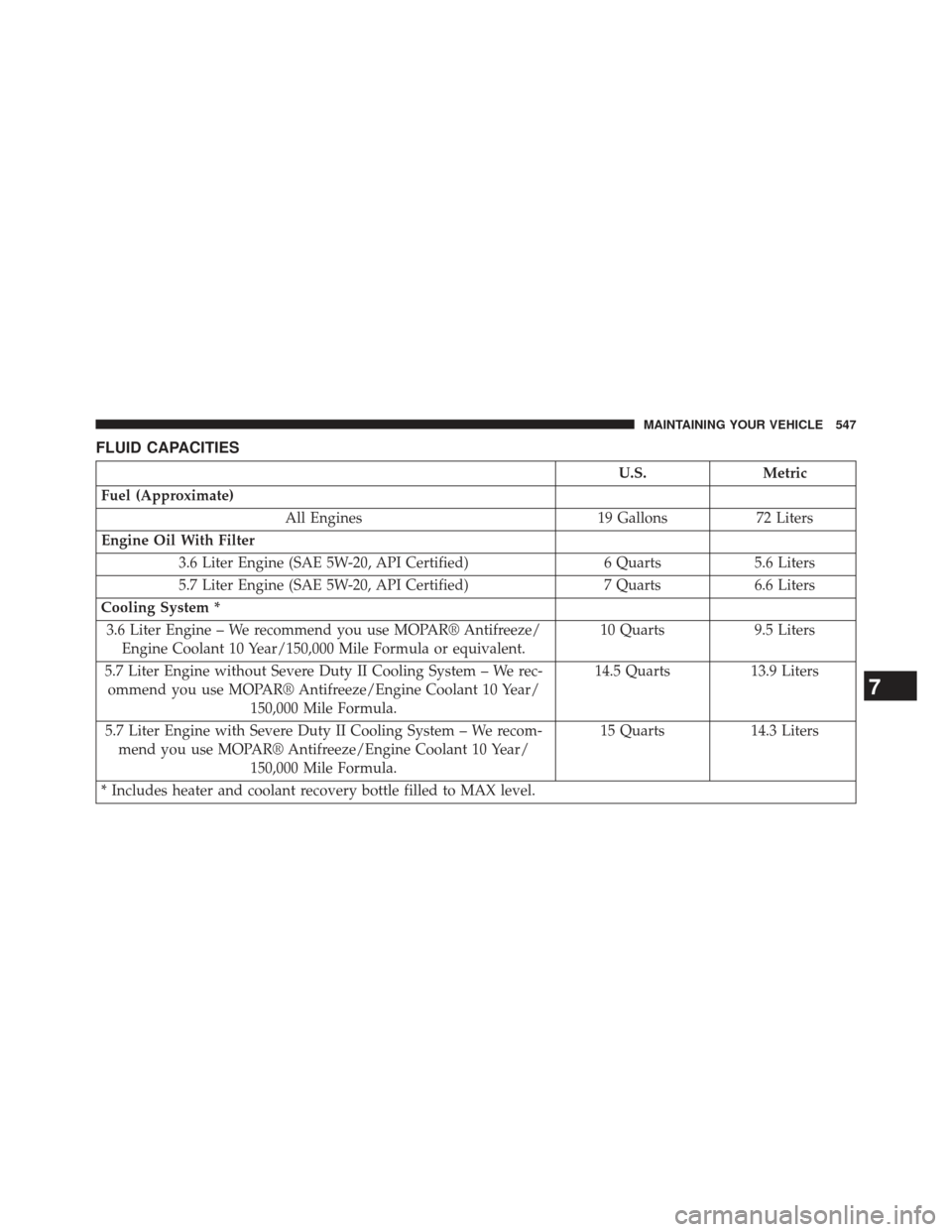
FLUID CAPACITIES
U.S.Metric
Fuel (Approximate) All Engines 19 Gallons72 Liters
Engine Oil With Filter 3.6 Liter Engine (SAE 5W-20, API Certified) 6 Quarts5.6 Liters
5.7 Liter Engine (SAE 5W-20, API Certified) 7 Quarts6.6 Liters
Cooling System * 3.6 Liter Engine – We recommend you use MOPAR® Antifreeze/ Engine Coolant 10 Year/150,000 Mile Formula or equivalent. 10 Quarts
9.5 Liters
5.7 Liter Engine without Severe Duty II Cooling System – We rec- ommend you use MOPAR® Antifreeze/Engine Coolant 10 Year/ 150,000 Mile Formula. 14.5 Quarts
13.9 Liters
5.7 Liter Engine with Severe Duty II Cooling System – We recom- mend you use MOPAR® Antifreeze/Engine Coolant 10 Year/ 150,000 Mile Formula. 15 Quarts
14.3 Liters
* Includes heater and coolant recovery bottle filled to MAX level.
7
MAINTAINING YOUR VEHICLE 547
Page 555 of 592
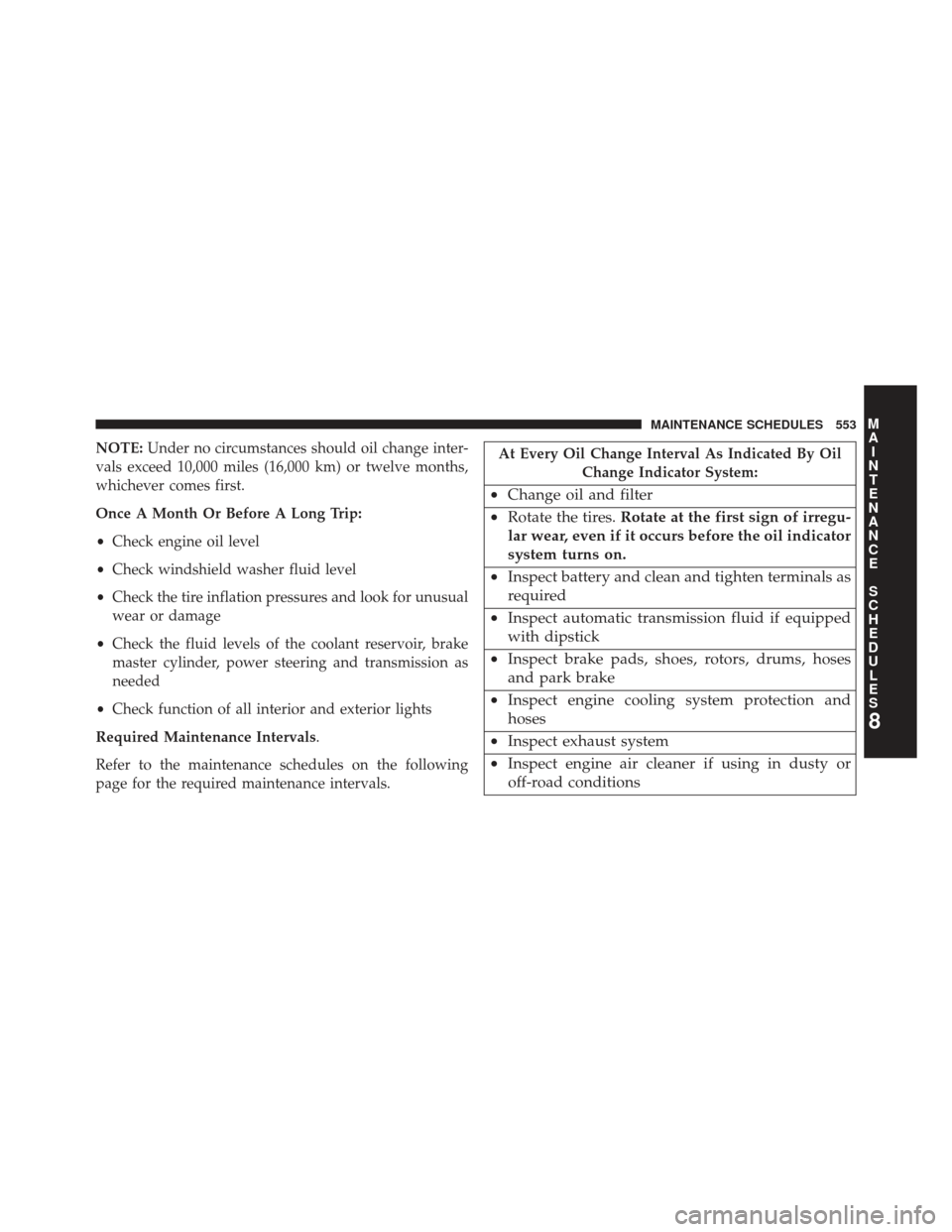
NOTE:Under no circumstances should oil change inter-
vals exceed 10,000 miles (16,000 km) or twelve months,
whichever comes first.
Once A Month Or Before A Long Trip:
• Check engine oil level
• Check windshield washer fluid level
• Check the tire inflation pressures and look for unusual
wear or damage
• Check the fluid levels of the coolant reservoir, brake
master cylinder, power steering and transmission as
needed
• Check function of all interior and exterior lights
Required Maintenance Intervals.
Refer to the maintenance schedules on the following
page for the required maintenance intervals.At Every Oil Change Interval As Indicated By Oil Change Indicator System:
•Change oil and filter
• Rotate the tires. Rotate at the first sign of irregu-
lar wear, even if it occurs before the oil indicator
system turns on.
• Inspect battery and clean and tighten terminals as
required
• Inspect automatic transmission fluid if equipped
with dipstick
• Inspect brake pads, shoes, rotors, drums, hoses
and park brake
• Inspect engine cooling system protection and
hoses
• Inspect exhaust system
• Inspect engine air cleaner if using in dusty or
off-road conditions
8
M
A I
N T
E
N
A
N
C E
S
C
H E
D
U L
E
SMAINTENANCE SCHEDULES 553
Page 575 of 592
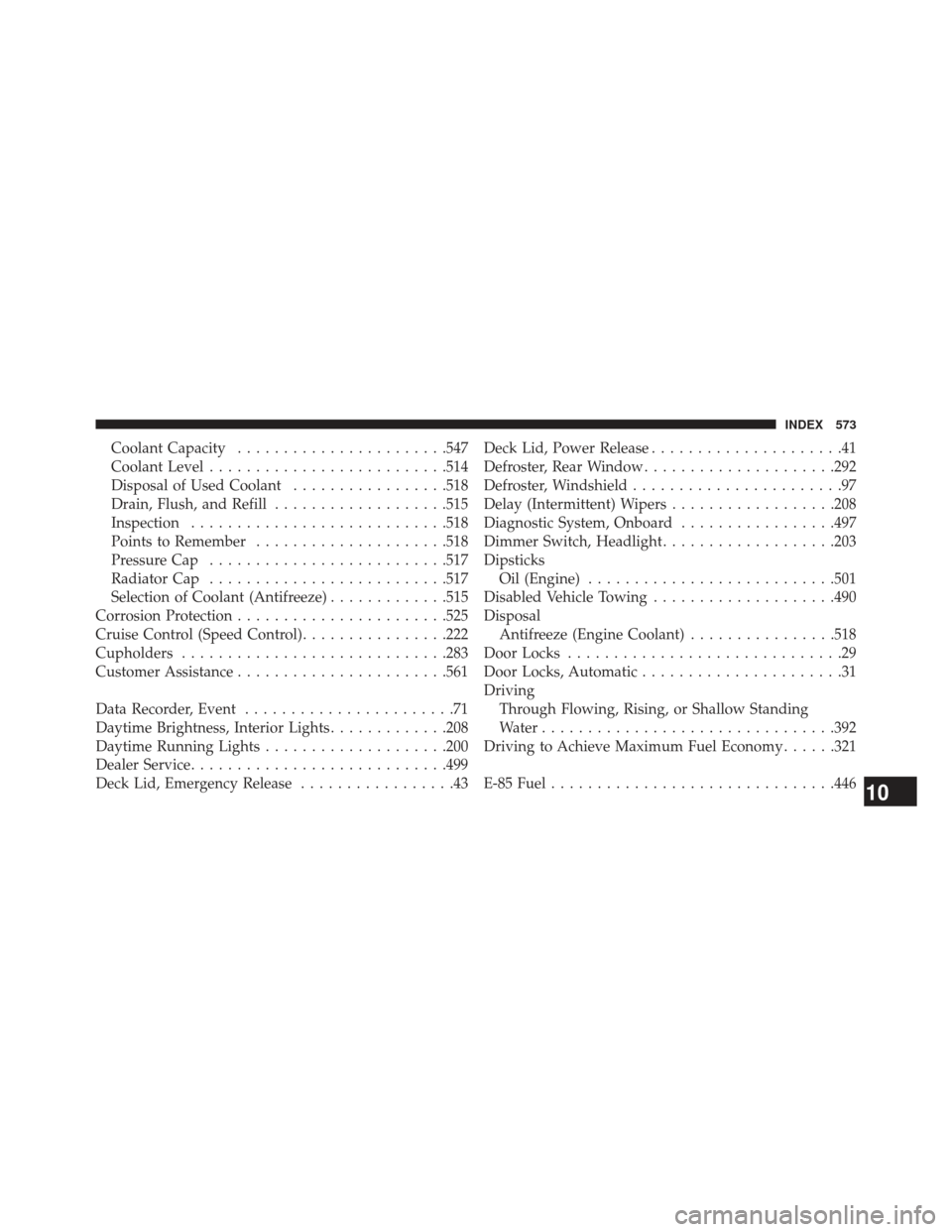
Coolant Capacity...................... .547
Coolant Level ......................... .514
Disposal of Used Coolant .................518
Drain, Flush, and Refill ...................515
Inspection ........................... .518
Points to Remember .....................518
Pressure Cap ......................... .517
Radiator Cap ......................... .517
Selection of Coolant (Antifreeze) .............515
Corrosion Protection ...................... .525
Cruise Control (Speed Control) ................222
Cupholders ............................ .283
Customer Assistance ...................... .561
Data Recorder, Event .......................71
Daytime Brightness, Interior Lights .............208
Daytime Running Lights ....................200
Dealer Service ........................... .499
Deck Lid, Emergency Release .................43Deck Lid, Power Release
.....................41
Defroster, Rear Window .....................292
Defroster, Windshield .......................97
Delay (Intermittent) Wipers ..................208
Diagnostic System, Onboard .................497
Dimmer Switch, Headlight ...................203
Dipsticks Oil (Engine) .......................... .501
Disabled Vehicle Towing ....................490
Disposal Antifreeze (Engine Coolant) ................518
Door Locks ..............................29
Door Locks, Automatic ......................31
Driving Through Flowing, Rising, or Shallow Standing
Water ............................... .392
Driving to Achieve Maximum Fuel Economy ......321
E-85 Fuel .............................. .446
10
INDEX 573
Page 576 of 592
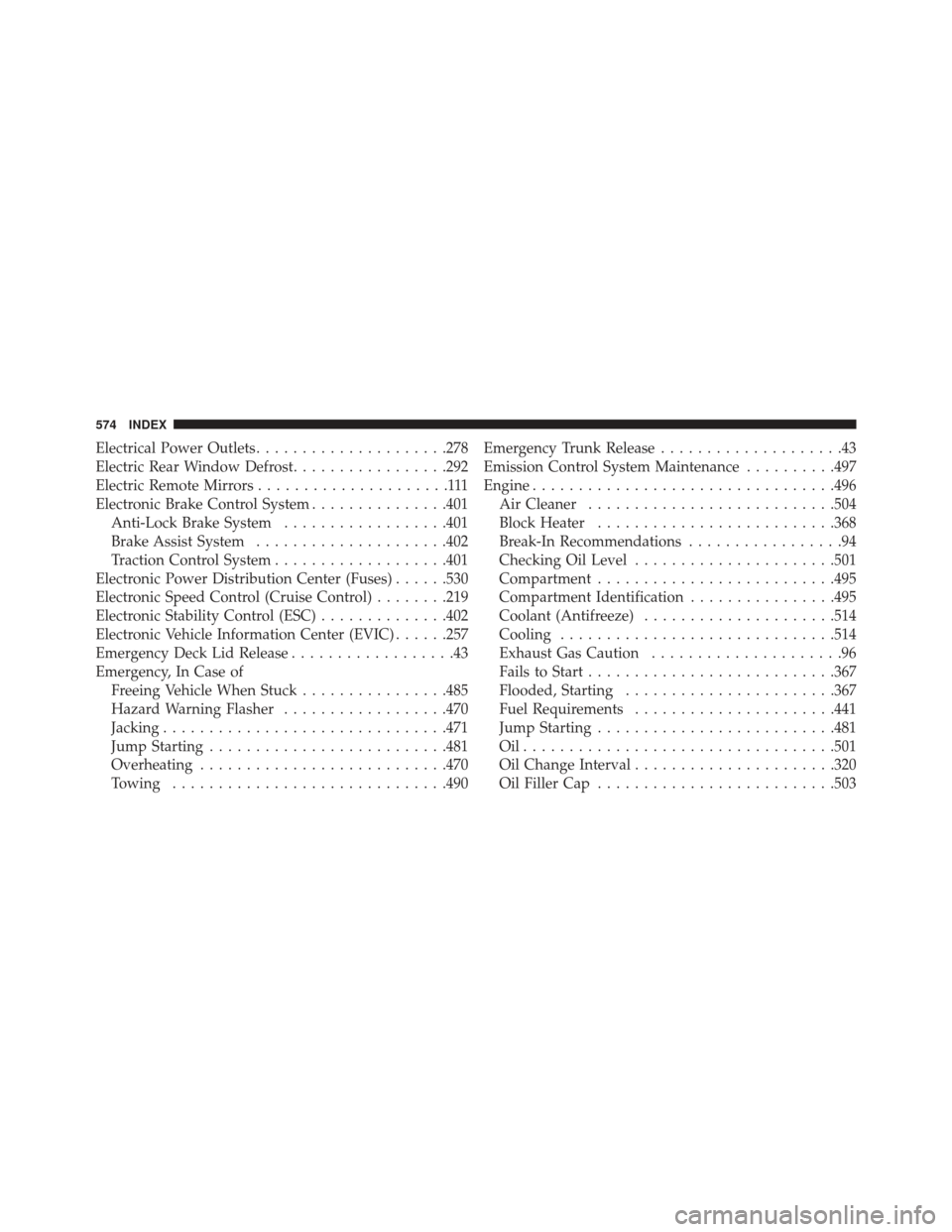
Electrical Power Outlets.....................278
Electric Rear Window Defrost .................292
Electric Remote Mirrors .....................111
Electronic Brake Control System ...............401
Anti-Lock Brake System ..................401
Brake Assist System .....................402
Traction Control System ...................401
Electronic Power Distribution Center (Fuses) ......530
Electronic Speed Control (Cruise Control) ........219
Electronic Stability Control (ESC) ..............402
Electronic Vehicle Information Center (EVIC) ......257
Emergency Deck Lid Release ..................43
Emergency, In Case of Freeing Vehicle When Stuck ................485
Hazard Warning Flasher ..................470
Jacking .............................. .471
Jump Starting ......................... .481
Overheating .......................... .470
Towing ............................. .490Emergency Trunk Release
....................43
Emission Control System Maintenance ..........497
Engine ................................ .496
Air Cleaner .......................... .504
Block Heater ......................... .368
Break-In Recommendations .................94
Checking Oil Level ..................... .501
Compartment ......................... .495
Compartment Identification ................495
Coolant (Antifreeze) .....................514
Cooling ............................. .514
Exhaust Gas Caution .....................96
Fails to Start .......................... .367
Flooded, Starting ...................... .367
Fuel Requirements ..................... .441
Jump Starting ......................... .481
Oil................................. .501
Oil Change Interval ..................... .320
Oil
Filler Cap ......................... .503
574 INDEX